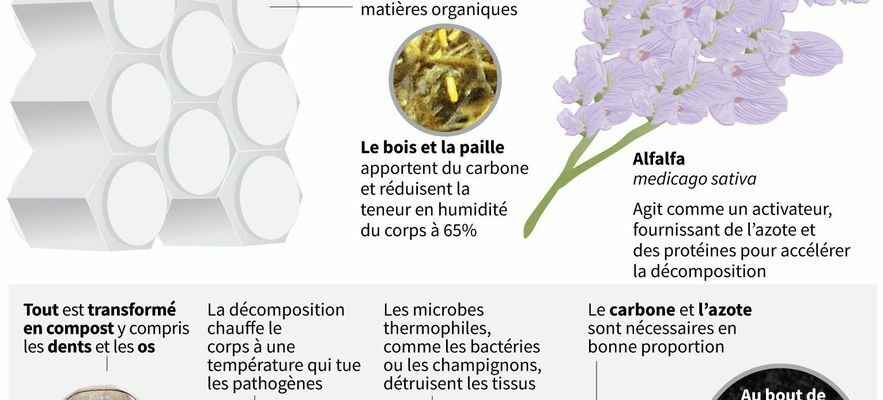“I want to be a tree when I die,” one post on the internet reads. Another shows a pretty nature decor with the slogan: “Compost me”. The campaign launched by supporters of humusation has won another victory. New York State just signed a law that allows human compost. It is the sixth state since 2019 to authorize this practice, which is considered to be much less toxic to the environment. That does not mean that New Yorkers will be able to throw their corpses into the compost bin at the bottom of the garden!
The device generally works as follows: the deceased is placed in a steel cylinder, on a bed of alfalfa, straw and wood shavings. A ventilation system supplies oxygen to the bacteria and micro-organisms which ensure decomposition in record time. It takes about a month for the body to be reduced to a state of compost. The remains are then sorted to remove the implants and crush the bones, then left to rest for another month. The heat caused by the organic reduction process apparently eliminates most harmful pathogens. Each individual produces 0.7 cubic meters of soil, or 18 large bags. The family can scatter them in their garden or entrust them to the undertaker who will scatter them in a park. “The soil created returns nutrients from our bodies to nature. It regenerates forests, captures carbon dioxide and fuels new life,” reads the site of Recompose, the pioneer of humusation.
The deceased remains present in another form, that of a tree for example
Its founder, Katrina Spade, is an architecture student when she suddenly becomes aware of the lack of “green” choices when it comes to funerals. “The terrible truth is that the very last thing most of us are going to do is poison the earth,” she said in a lecture. The cremation of a single corpse emits more than 220 kilos of CO2, the equivalent of an 800 kilometer car journey, and mercury from dental fillings, not to mention the energy consumption. If we multiply by the 2 million incinerations in the United States, the impact on the planet becomes worrying. The burial is not much better. It takes quantities of wood and metal to produce a coffin, concrete for the vault and liters of formaldehyde known to be carcinogenic to preserve the remains.
Katrina Spade, inspired by farming where dead animals are buried under organic waste, created her company in Seattle in 2014. It consists of a series of receptacles stacked on top of each other, like the cells of a beehive, each of which houses a person. Since then other companies have followed.
The burial of the deceased on the ground has been practiced for millennia. “The difference is that the body is seen as a nutritional resource that generates new life. The dead remains present in another form, that of a tree for example. A kind of reincarnation”, analyzes Philip Olson, professor at Virginia Tech and specialist in funeral practices.
© / afp.com/John SAEKI
Humusation is not only a greener solution (although not more economical) but also more functional. The number of deaths in the United States reached 3.4 million in 2021. At this rate, cemeteries will quickly fill up. However, it will take time to become popular, says Professor Olson. “People have to get used to this practice, which is considered bizarre and a little scary. There is a lot of resistance to change. Cremation, for example, dates back to 1876 in the United States, but in 1963 it represented only 4% of funerals” .
Obviously, the use of human soil to fatten apple trees or begonias arouses many reactions of disgust. Catholic clergy in New York state have opposed the bill, which they say prevents “protecting and preserving basic human dignity and respect.” “A perfectly appropriate process for returning vegetable peelings to the ground is not necessarily appropriate for the human body”, which is “the receptacle of the soul”, affirms Dennis Poust, the director of the Catholic Conference. Recompose has “composted” over 200 people so far.
